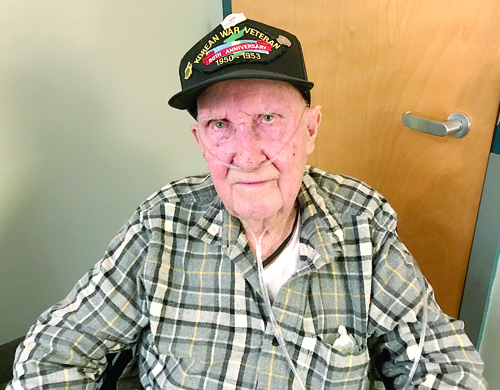Veteran: ‘War scars people internally’

(De Busk Photo)
By Dawn De Busk
Staff Writer
SOUTH PARIS — Harold Leino has kissed American soil.
He did so after returning from 15 months of frontline combat duty during the Korean War.
“Whenever we came back to America, there were 10 of us in all different branches of the military. We said, ‘When we get off the ship in Seattle, we are going to kiss the ground.’ We got off the gangplank and all 10 of us got on the ground and kissed it. When we left, we didn’t think we would ever come back. A lot of them didn’t.”
A couple years ago, in 2022, Leino went on an Honor Flight and traveled to the Korean War Monument where he found the names of three soldiers who were his friends.
“I felt that those were the real heroes. They didn’t come back. They were 19 or 20 years old,” he said.
Serving in Korea was unnerving. There were no breaks on the frontlines. When the artillery fire and bullets weren’t doing damage, the weather did a number on the soldiers. Winter temperatures dropped to 40 below zero and monsoons dominated the summer months.
Despite all that, Leino declares he would serve again.
“If you asked me, I would go again. I love this country. I never seen any better,” he said.
He paused for a moment to recall soldiers returning to America and kissing the ground that they thought they’d never walk upon again.
“I guess we did something for this country by fighting Communism,” he said. “South Korea turned out to be a big country. North Korea still doesn’t have any lights on at night.”
Currently, Leino is living at the Maine Veterans Homes in South Paris.
A couple months ago, Leino moved from his home in Harrison to the Veterans Home. He broke a disc in his back while putting gas in his lawn mowing tractor. He is on the mend now. Due to the injury, he traded in living alone for the comfort of caregivers and the company of fellow veterans.
Last week, Leino shared his stories of the Korean War.
If he could have done anything differently, he and his fellow soldiers would have worn clothes more appropriate for the extreme cold. Also, he wishes there had been more services to help veterans cope with Post Traumatic Stress Disorder (PTSD).
Still, he does not regret serving his country.
Korea: Place of extremes
He was a combat infantry man in Korea from 1952 to 1954, a little longer than 15 months.
“That war started in 1950. It ended on July 27, 1953,” Leino stated. “There were 36,000 soldiers that died there in a short while, in about three years’ time.”
He explained why it is referred to as the Forgotten War.
“It was a politician’s war. They didn’t want to be in a big war right after the second world war. They kept it quiet,” he said.
“There are a lot of things Americans don’t know about the Korean War. That war was a Russian war. Everything that they fought with were made in Russian. I had artillery shells or pieces of shell that were made in Russia. The MiGs were from Russia. Those were that fighter planes that the Russians had. They claimed the North Koreans were flying them. But America didn’t broadcast it because America didn’t want another war after WWII,” he said.
The weather was another brutality in Korea.
“It was extreme 40 below zero. I froze my hands and feet. It was in the mountains, and we didn’t have the right kind of clothes. We had cotton clothes,” he said.
If Leino could supply the uniforms to fellow soldiers in Korea, “They would have to have something made out of wool. I would make sure they had boots and mittens to keep their hands from freezing,” he said.
“I have fingers now that can’t get an oxygen reading because they were frost bitten so bad” from exposure to the cold, he said.
“Overseas, we were living outside. You can’t imagine what it is like to be living outside in the middle of the winter,” he said.
“When my wife and I were getting married. I told her, ‘I am never going to camp. I have done my camping.’ I told her I had lived for 15 months outside,” Leino said.
Summer was no better as far as the weather was concerned.
“During the summer, it was rainy. They had those monsoon rains. All the rivers were flooded. All the snakes in Korea were poisonous. I only saw one. I had a shot at it. There was a river that was flooded so we had to drive alongside it quite a ways. There was a snake. It was about 9 inches in diameter and about 6 feet long. The driver drove over it. I was going to shoot it, but it went into the river. I was pretty good with a rifle, and hit it before it slipped into the water. That is the only snake I saw,” he said.
“They had bob cats. But the country was bombed up so bad nothing could live in the woods anyway. The hills were bare,” he said.
When Leino and his friends got homesick, they would talk about what they missed about home.
“What I missed the most was having milk. I still drink a lot of milk. We didn’t have any fresh milk in Korea. It was dehydrated,” he said.
“What bothered me a lot is all the kids that were orphans. Seoul is a big city now, 14 or 15 million. When I was there, there weren’t any buildings left. One time, we had to pick up a new vehicle and we had to drive through Seoul. It was wintertime, we passed a building with walls missing. Inside it were a bunch of little kids, some were 1-or 2-years old. There were older kids, too,” Leino recalled. “American soldiers are big hearted. We stopped. Everyone dug in their pockets for candy bars. I had powered milk. I had several packets. I gave it to one kid and he started eating it dry. I told him to mix it with water. He didn’t understand. They could have made a couple gallons of milk.”
“I saw a lot of starving kids. Their parents had been killed. It was a bad time,” he said.
Of the North Korean forces, 1.5 million people were killed. Also, it is estimated that 2 million North and South Korean civilians died during the war, according to the National Army Museum.
Returning home from war
The fact that Leino was an excellent marksman stemmed from growing up in Maine. He learned how to use a gun for hunting. That skill came in handy during wartime.
“That is why we were on the front line. Most of us from Maine, we could shoot. I never had a problem with that,” he said.
“The hardest thing I had when I come back from overseas was adjusting. I went from a farm to basic training. They showed you how to kill people. I had a colonel who told us not to get in any fights because we were liable to kill somebody. We were trained to be able to kill somebody with our bare hands,” he said.
“For six or seven years, I had a hard time. They didn’t have anything for us, even at VA. After the Vietnam War, they figured out about Post Traumatic Stress,” Leino said.
“We all had it — those of us in combat,” he said.
“After the WWII, there were a lot of veterans that ended up drinking to try to forget. But, you don’t forget those memories. After all those years, they come back,” he said.
“War scars people internally. Maybe, we didn’t get wounded physically, but we got wounded in different ways,” he said.
He wishes more had been known about PTSD when he initially returned to the United States.
“They [the VA] made a big difference in the last few years” in addressing the stress and anxiety that military personnel experience during and after wartimes.
“War, itself, you can’t really change,” he said.
There is a trait that Leino has of being of service to others. This personality trait led him to serve his country, to do a difficult job so others could have a better life.
At the Veterans Home, in the cafeteria, Leino sits next to someone who is going blind. He offers his help because that is what people do, they help one another when they can, he said.

